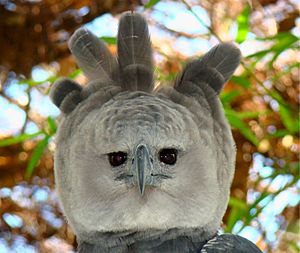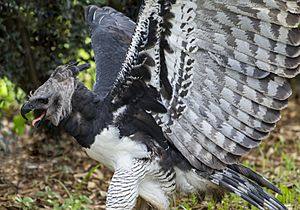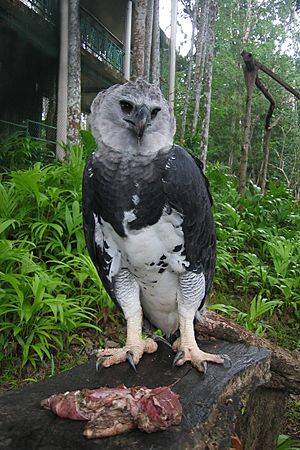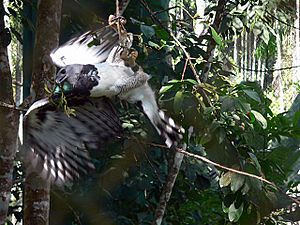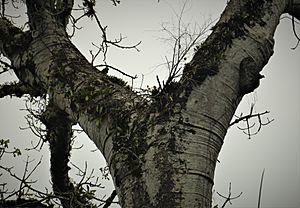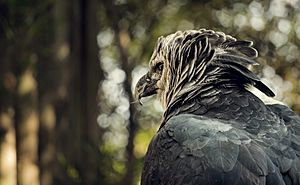Harpy eagle facts for kids
Quick facts for kids Harpy eagle |
|
|---|---|
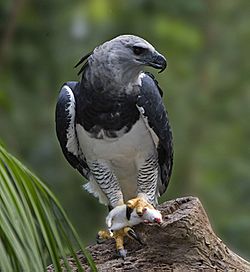 |
|
| Conservation status | |
| Scientific classification | |
| Kingdom: | |
| Class: | |
| Order: | |
| Family: | |
| Genus: |
Harpia
Vieillot, 1816
|
| Binomial name | |
| Harpia harpyja (Linnaeus, 1758)
|
|
 |
|
| The harpy eagle is rare throughout its range, which extends from Mexico to Argentina | |
The harpy eagle (Harpia harpyja) is a huge and powerful eagle that lives in the rainforests of Central and South America. It's also known as the American harpy eagle. This helps tell it apart from the Papuan eagle. It is one of the biggest and strongest raptors in the world. Harpy eagles usually live high up in the trees of tropical rainforests.
Sadly, their homes are being destroyed. This means they are disappearing from many areas, especially in Central America. In Brazil, people sometimes call the harpy eagle the "royal-hawk". The name harpy comes from Ancient Greece. It refers to the Harpies from Greek myths. These were wind spirits with an eagle's body and a human's face.
Contents
Where Harpy Eagles Live
The harpy eagle lives from Mexico all the way south to Argentina. They are found throughout Central America and South America. In rainforests, they live in the very tallest trees. These eagles are most common in Brazil.
However, they are almost gone from Central America. This is because many rainforests there have been cut down. Harpy eagles hunt in the forest canopy, which is the top layer of trees. They also sometimes hunt on the ground. They like to perch on tall trees to look for prey.
What Harpy Eagles Look Like
The top part of a harpy eagle is covered with dark, slate-black feathers. Their underside is mostly white. Their legs, called tarsi, have black stripes. A wide black band crosses their chest, separating their gray head from their white belly.
Their head is light gray and has a cool double crest of feathers. The top of their tail is black with three gray bands. The underside of the tail is black with three white bands. Their eyes can be gray, brown, or red. The base of their beak is black, and their toes are yellow. Male and female harpy eagles look exactly the same.
Their talons can be up to 13 cm (5.1 in) long. Female harpy eagles are bigger than males. Females usually weigh 6 to 9 kg (13 to 20 lb). Males are smaller, weighing about 4 to 4.8 kg (8.8 to 10.6 lb). Harpy eagles are 86.5 to 107 cm (2 ft 10 in to 3 ft 6 in) long. Their wingspan is 176 to 224 cm (5 ft 9 in to 7 ft 4 in).
The harpy eagle has a relatively short wingspan for its size. This helps it fly easily through thick forest trees.
Harpy eagles are usually quiet when they are away from their nest. Near the nest, adults make a loud, sad scream. Males make a "whispy screaming" sound. Females make similar calls, but they are lower in pitch. When a male brings food to the nest, he makes chirps and goose-like calls.
As the baby eagles grow, the parents call less, and the babies call more. Baby eagles make a "chi-chi-chi" sound when they are alarmed, like when it rains or the sun is too strong. If people come near the nest, the baby eagles might make croaks, quacks, and whistles.
What Harpy Eagles Eat
Adult harpy eagles are at the very top of the food chain. Other animals rarely hunt them. Their main food is tree-dwelling mammals. They mostly eat sloths and monkeys. They also hunt birds like macaws and other parrots.
Sometimes, they eat reptiles like iguanas, tegus, and snakes. They have been known to catch over 100 different types of prey. Very rarely, they might hunt farm animals like chickens, lambs, goats, or young pigs. But this is not common. Harpy eagles help control the number of smaller predators, like Capuchin monkeys. These monkeys eat bird eggs, and without the eagles, they could cause other bird species to disappear.
Harpy eagles have the biggest talons of any living eagle. They can lift prey that weighs as much as they do. This allows them to grab a live sloth from a tree branch. Female harpy eagles often snatch large male howler or spider monkeys. They can also grab full-grown sloths that weigh 6 to 9 kg (13 to 20 lb). They fly off without landing, which shows their amazing strength.
Sometimes, harpy eagles hunt by "sit-and-wait." This means they sit on a high perch for a long time. They watch for prey near open areas, rivers, or salt-licks. Many mammals go to salt-licks for nutrients. A more common way they hunt is "perch-hunting." They fly short distances from tree to tree, stopping to look for prey. When they see something, they dive quickly and grab it. They might also hunt by flying within or above the forest canopy.
Harpy Eagle Reproduction and Life Cycle
Harpy eagles often build their nests in the top of a kapok tree. These are some of the tallest trees in South America. In many South American cultures, it's considered bad luck to cut down a kapok tree. This helps protect the eagles' homes. They also use other huge trees, like the Brazil nut tree, for nesting.
A pair of harpy eagles lays two white eggs in a large stick nest high in a tree. However, they usually only raise one chick every 2 to 3 years. After the first chick hatches, the second egg is often ignored and does not hatch. The male eagle brings most of the food for the female and later for the baby eagle. The male also takes turns sitting on the nest while the female hunts for food.
The baby eagle grows its flight feathers in about six months. But its parents continue to feed it for another 6 to 10 months. Harpy eagles can be aggressive toward humans who bother their nests or seem to threaten their young.
Protecting Harpy Eagles
Globally, the harpy eagle is considered Near Threatened by the IUCN. This means they are close to being endangered. They are also threatened with extinction by CITES. The Peregrine Fund used to say they needed special help to survive. Now, they agree with the "Near Threatened" status. Many projects are working to help bring the species back in different countries.
The harpy eagle is considered critically endangered in Mexico and Central America. It has disappeared from most of its old homes there. In Mexico, it used to live as far north as Veracruz. Today, it probably only lives in Chiapas. In South America, it is considered Near Threatened or Vulnerable. In Argentina, it is only found in the Parana Valley forests of Misiones Province. It has disappeared from El Salvador and almost from Costa Rica.
Harpy Eagles in Popular Culture
The harpy eagle is the national bird of Panama. It is shown on the coat of arms of Panama. A harpy eagle named "Hope" was released in Belize. She was called an "Ambassador for Climate Change" because of a big climate change meeting in 2009. The harpy eagle also inspired the design of Fawkes the Phoenix in the Harry Potter film series.
Images for kids
-
A skull exhibited at the Museum für Naturkunde, Berlin
-
A stuffed specimen of a harpy eagle preying on a macaw at the Museum für Naturkunde, Berlin
-
Along with sloth, monkeys, such as the tufted capuchin (Cebus appella), are one of main prey of harpy eagle.
-
Depiction of harpy eagles in Maya codices according to the 1910 book, Animal figures in the Maya codices by Alfred Tozzer and Glover Morrill Allen
See also
 In Spanish: Águila arpía para niños
In Spanish: Águila arpía para niños



